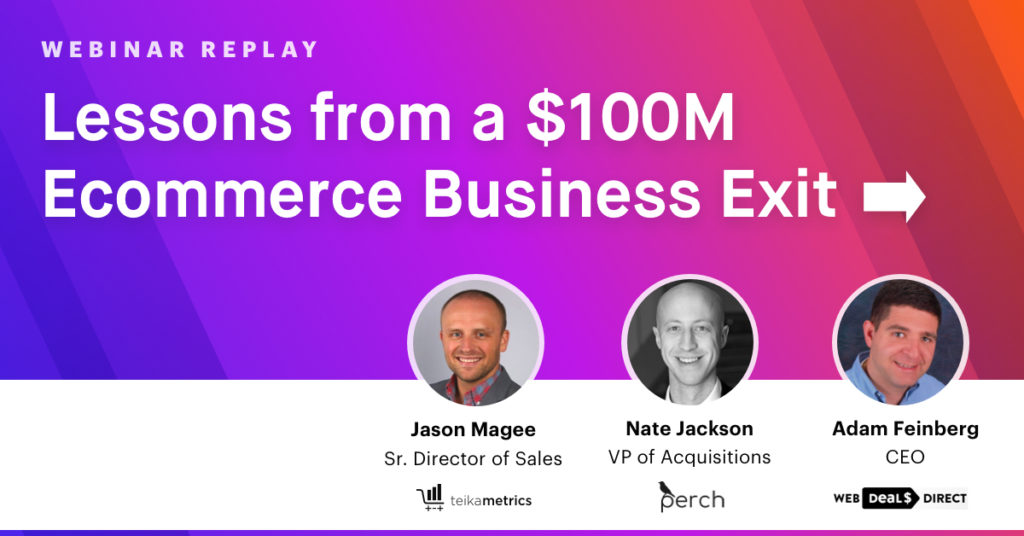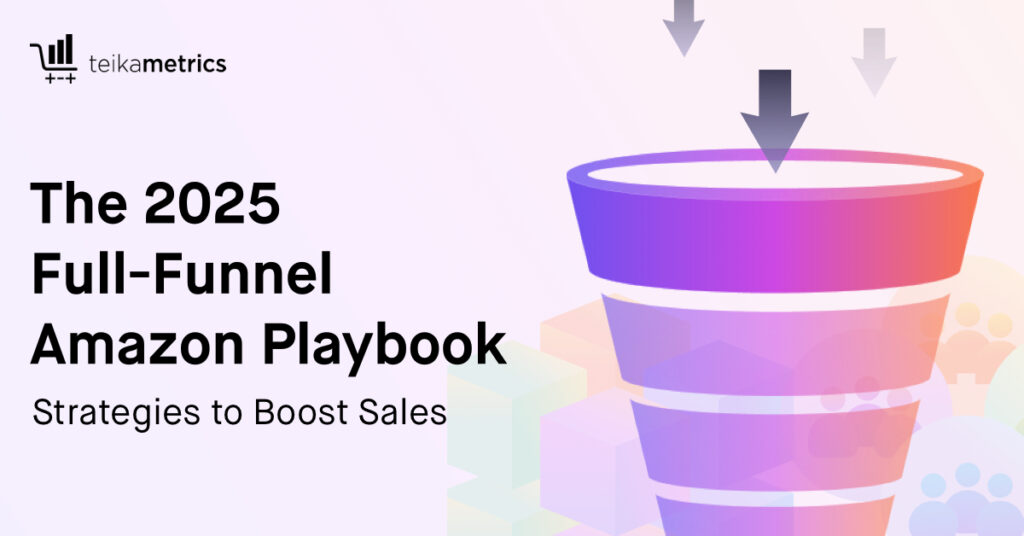What’s your plan to get your ecommerce business acquired? Are you taking the necessary steps now to put yourself in the best position when you’re ready to sell?
In just six years, Adam Feinberg grew Web Deals Direct from a small, independent white-label seller, into a massive eight-figure powerhouse that prompted a $100M acquisition by Perch in 2021.
In this webinar, Adam joins Perch and Teikametrics for a deep discussion on the brand’s journey, tactics and strategies that helped make their growth possible, and what lessons sellers like you can apply to your own marketplace businesses.
Webinar Topics
- Roadblocks Web Deals Direct overcame initially on Amazon
- Adam’s decision-making process as he sustainably grew the business
- Advertising strategies that were key to their success as they scaled
- The acquisition process with Perch, and what other sellers can learn from their experience
Show Links
- Connect with Adam Feinberg
- Connect with Nate Jackson
- Follow Perch & watch Cameron Yoder’s conversation with Perch CEO Chris Bell
- Connect with Jason Magee and Andrew Waber
- Follow Teikametrics
Watch the Webinar Replay
Webinar Highlights
For Web Deals Direct, success came from starting small
Adam says he built Web Deals Direct from the ground up, starting small with products he felt confident would turn a profit.
“So that was our strategy, to find products, at the time we thought could be the 10th bestseller and sell 10, 15 units a day at a $10 profit…
We thought particularly small. If we could make 300,000 bucks a year and split it and make 150,000 a year — looking back seven years ago, I thought that was a fantastic result considering how little we had to put in.” – Adam Feinberg
Branding helped differentiate their products
Instead of just throwing products up on Amazon, Web Deals Direct took the time to brand the products to create something customers could connect with better and place more trust in, differentiating them from other products on Amazon.
“The other strategy that we really tried to do is we thought that if we branded everything, highly targeted to try to convert everything the same way we do for SEO, that it would have a good chance of being successful.
Someone wants to buy a nail lamp from a nail lamp company. They don’t want to buy it from some generic Chinese brand and they’ll pay a little bit more for something like Bella Nails than just some horrible sounding store.
So our space saver bags brand was Spacesaver, our nail lamp brand was Bella Nails. Bluetooth speakers were our very first product. Our brand was Uber Audio and we were trying to establish ourselves as a legitimate provider of this product instead of some Chinese junk you’re buying on Amazon.” – Adam Feinberg
A cohesive brand strategy continues to be beneficial
Nate said that Web Deals Direct’s strategy of brand-building continues to have power on the marketplace.
“It’s a little bit unconventional. I think a lot of people had a trademark and they said, I’m going to go source the products and I’m going to see what sticks. And so there are good brands that we bought that do not have this sort of cohesive brand theme that Adam and Rich’s brands do.
But when in doubt having that cohesive theme is definitely a stronger and preferable thing.
I do think that there are some categories where that branding resonates and matters more — anything where there’s a premium aspect to it. Whereas there are some pure utility-based purchases where someone’s buying a plastic fork and they probably don’t even notice what the trade name is, and maybe what other products the seller is selling.” -Nate Jackson
It’s not just about branding a single product
Jason highlighted the importance of IP and the total brand package which enables that brand to expand.
“When somebody goes to sell their business, number one, you guys had to think about IP and what you own.
Having a brand, if you think about the stages, the ideal of minimum is you own that brand. So you own the products, you own the IP, you own the MAP policy, et cetera. Even if it’s a single item brand that is a lot more valuable from an acquisition perspective, than reselling or having a store that sells other people’s products.
But then if you take it to the next level, which is what Adam did– I want to have a Spacesaver brand. So not only can you have the space saver packs, anything related to the concept of saving space, you can build complementary products around that.” Jason Magee
Launching a new product takes capital investment
Jason talked about product lifecycles and how launching a new product always requires capital to advertise.
“We think about this at Teikametrics a lot: Hey, where is your product in its lifecycle? Is it a brand new launch, et cetera. That helps determine what you need to do and what you should expect.
When you’re launching a brand new SKU, you cannot expect it to be profitable. You’re going to lose money, but that’s like getting a rocket off of the launch pad and you got to burn a lot of gas, got to burn a lot of capital to get it into orbit and establish that product-market fit. So you have to be realistic about, Hey, I’m not trying to make a profit on day one. This isn’t a get rich quick scheme.” -Jason Magee
Quality listings bring results
Nate says listing optimization is key to success. A listing should have an image that pops and SEO keywords incorporated.
“The main thing is how it pops. The main image is hugely important for consumer selection. All of the actual keywords and titles are key for the indexing and the searchability.
And for me, I end up seeing the results in the business performance. So that’s where I see it first. So when I look at the quality of the listing, it helps explain why I’m seeing such terrific business results.” -Nate Jackson
Advertising kickstarts the flywheel
Jason talked about how advertising kickstarts the flywheel on Amazon. Advertising on Amazon isn’t just about driving each individual sale, it’s about raising organic rank.
“Every sale you get from advertising, you’re putting a coin in the piggy bank of Amazon or Walmart that I deserve to rank better organically.
So in a way, unlike Google or off-Amazon advertising, the more you advertise, the better you rank organically. It’s not really about your ACOS. It’s what is the ACOS I can stomach that drives organic sales fast. To what Nate said and what Adam was saying, you have to start by understanding your profit margin… You need to know how to advertise a 10% margin versus a 70% margin item…
The way we look at this is how do shoppers buy products? 78% of search terms are generic. So if that’s not your biggest bucket, you can be in trouble. You need to protect your brand, but you also need to go after competitors.” – Jason Magee





